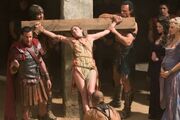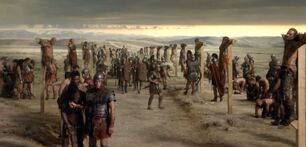No edit summary |
No edit summary |
||
| (16 intermediate revisions by 10 users not shown) | |||
| Line 1: | Line 1: | ||
| − | [[File: |
+ | [[File:Spartacus..jpg1.jpg|thumb|left]]'''Crucifixion''' is the execution involving being suspended from a cross, stake, or tree by rope, nails, or both. Crucifixion was used throughout the Mediterranean and Middle East in various forms throughout antiquity. By the Roman Republic, crucifixion was the form of execution reserved for slaves and traitors, due to its torturous degradation of the condemned. The condemned was stripped naked and secured to the gibbet in a variety of postures, all intended to immobilize the condemned and render him, or her, a helpless object of contempt and revulsion. The proximate cause of death varied from case to case, depending on the precise method of crucifixion. The condemned might linger for hours or even days before ultimately succumbing to asphyxia, cardiac arrest, thirst, or exposure. |
| − | Although the exemplary purpose of crucifixion was best served by permitting the condemned to linger in agony as long as possible, in some cases, in order to speed death, the legs of the condemned would be broken, increasing the agony of suspension but causing internal bleeding leading more swiftly to shock, embolisms in the |
+ | Although the exemplary purpose of crucifixion was best served by permitting the condemned to linger in agony as long as possible, in some cases, in order to speed death, the legs of the condemned would be broken, increasing the agony of suspension but causing internal bleeding leading more swiftly to shock, embolisms in the bloodstream, asphyxia, and death. |
| + | In [[The Dead and the Dying]], [[Agron]] is crucified but later taken down and returned to the rebels as part of Crassus' bargain. |
||
| ⚫ | |||
| ⚫ | |||
| − | ==Characters Who Are Killed By Crucifixion== |
||
| + | |||
| + | |||
| + | [[File:Rabcross.jpg|thumb|306px|The rebels being crucified ]] |
||
| + | ==Crucified Characters== |
||
*[[Segovax]] |
*[[Segovax]] |
||
*[[Thessela]] |
*[[Thessela]] |
||
*[[Marcia]] |
*[[Marcia]] |
||
| + | *[[Donar]]- Hung after death |
||
| + | *[[Agron]] - Survived, as he was a part of Crassus' bargain with Spartacus. |
||
| + | *[[Gannicus]] |
||
| + | *[[Kore]] |
||
| + | *[[Rabanus]] |
||
| + | *[[Litaviccus]] |
||
| + | *[[Kraynos]] |
||
[[Category:Terminology]] |
[[Category:Terminology]] |
||
| − | [[Category: |
+ | [[Category:Methods of Killing]] |
Latest revision as of 01:13, 28 November 2014

Crucifixion is the execution involving being suspended from a cross, stake, or tree by rope, nails, or both. Crucifixion was used throughout the Mediterranean and Middle East in various forms throughout antiquity. By the Roman Republic, crucifixion was the form of execution reserved for slaves and traitors, due to its torturous degradation of the condemned. The condemned was stripped naked and secured to the gibbet in a variety of postures, all intended to immobilize the condemned and render him, or her, a helpless object of contempt and revulsion. The proximate cause of death varied from case to case, depending on the precise method of crucifixion. The condemned might linger for hours or even days before ultimately succumbing to asphyxia, cardiac arrest, thirst, or exposure.
Although the exemplary purpose of crucifixion was best served by permitting the condemned to linger in agony as long as possible, in some cases, in order to speed death, the legs of the condemned would be broken, increasing the agony of suspension but causing internal bleeding leading more swiftly to shock, embolisms in the bloodstream, asphyxia, and death.
In The Dead and the Dying, Agron is crucified but later taken down and returned to the rebels as part of Crassus' bargain.
During the third servile war, Marcus Crassus crucifies 6000 rebel slaves.

The rebels being crucified